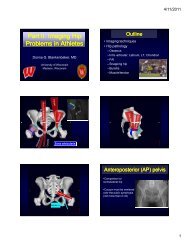Ankle and Foot 47 - Department of Radiology - University of ...
Ankle and Foot 47 - Department of Radiology - University of ...
Ankle and Foot 47 - Department of Radiology - University of ...
Create successful ePaper yourself
Turn your PDF publications into a flip-book with our unique Google optimized e-Paper software.
2286 VII Imaging <strong>of</strong> the Musculoskeletal System<br />
Figure <strong>47</strong>-92. A 34-year-old man came to the<br />
emergency department complaining <strong>of</strong> acute<br />
onset <strong>of</strong> nontraumatic pain <strong>of</strong> his left great toe.<br />
A, Anteroposterior radiograph <strong>of</strong> the left foot, with the<br />
area in the dashed box magnified to the right. A thin,<br />
white, curved line was observed just outside the<br />
lateral diaphyseal cortex <strong>of</strong> the first metatarsal<br />
(ellipse). Initially, this was mistakenly thought to<br />
present a periosteal reaction from the first metatarsal,<br />
rather than what it truly was: an eroded lateral<br />
sesamoid. There is also a marginal erosion <strong>of</strong> the<br />
medial first metatarsal head (white arrow). B, Axial CT<br />
scan through the sesamoids <strong>of</strong> the great toes<br />
bilaterally shows two normal sesamoids on the right,<br />
whereas on the left only a thin shell <strong>of</strong> the eroded<br />
lateral sesamoid remains (ellipse).<br />
A<br />
B<br />
joint fluid reveals strongly negative birefringent crystals<br />
under a polarizing microscope. CT is seldom used in the<br />
workup <strong>of</strong> gout. However, CT scans <strong>of</strong> the feet obtained<br />
for other reasons may unexpectedly reveal the finding <strong>of</strong><br />
gout (Fig. <strong>47</strong>-92).<br />
• Arthrodesis<br />
When the chronic pain from severe arthritis cannot be<br />
controlled medically, a surgical arthrodesis may be<br />
desirable. Once solid bony fusion across the joint has been<br />
achieved, that fused joint should be pain free. And even<br />
though the patient no longer has any motion at that joint<br />
after arthrodesis, before arthrodesis the joint may have<br />
been so limited by pain <strong>and</strong> lack <strong>of</strong> articular hyaline cartilage<br />
that the patient may have had very little functional<br />
range <strong>of</strong> motion to begin with.<br />
When patients remain symptomatic after an attempted<br />
arthrodesis, CT can be used to assess the degree <strong>of</strong> solid<br />
bony bridging, if any. Although there may be several metal<br />
plates <strong>and</strong> screws within the scanning FOV, these tend to<br />
cause relatively little CT streak artifact, especially when<br />
Ch0<strong>47</strong>-A05375.indd 2286<br />
9/9/2008 5:35:38 PM
















